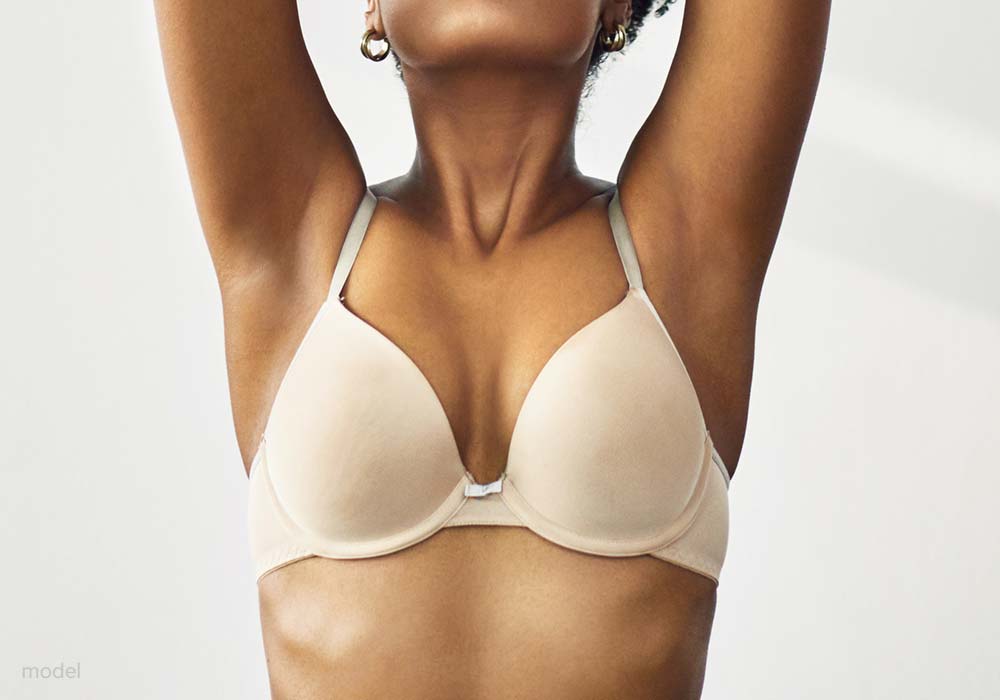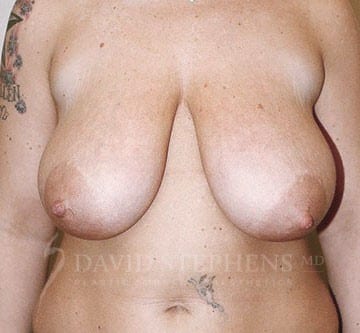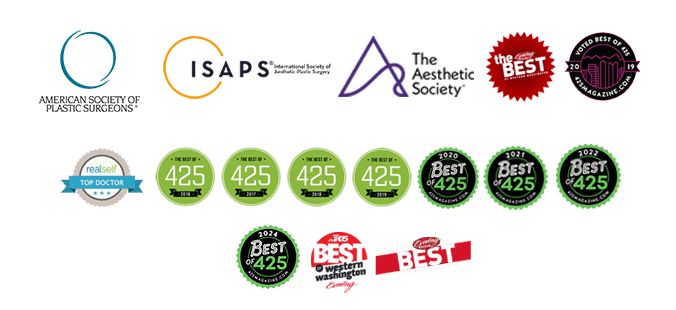Breast Lift
Schedule A ConsultationModel
The breast lift, or mastopexy, describes several types of procedures that lift sagging or misshapen breasts. Breast Ptosis, or sagging breasts, may occur for several reasons, including the inability of the skin and breast tissues to hold up a normally developing but full breast; the changes during pregnancy and breastfeeding resulting from initial breast engorgement causing stretching of the internal breast ligaments and skin after which the breast deflates and sags following breastfeeding; significant deflation due to weight loss; or developmental changes that result in misshapen breasts. Regardless, the higher breast typically found in youth falls with gravity and the loss of thicker collagen in the breast tissue matrix and thinning skin. The tissues just can’t hold up the weight of the breast, leaving it and the nipple too low, resulting in discomfort and the appearance of it being too low on the chest and even over the upper abdomen. There is an absence of the breast on the upper chest and the loss of cleavage and the youthful female silhouette.

What is a Breast Lift?
Mastopexy, or breast lift surgery, is actually a group of procedures that change and elevate the nipple and the breast “mound” on the chest. The type of mastopexy used depends on the severity of nipple sagging, the amount of breast tissue, the nipple size, and the amount of excess skin. Plastic surgeons reshape and lift the breast simultaneously, using the woman’s own breast tissue if available, called “autoaugmentation”. Adding implants may be done to provide improved shape or to enlarge the lifted breast, which is called “augmentation mastopexy.”
There is typically too much skin in sagging breasts. For less excess skin and a slightly lower nipple/areola, the “donut” lift just removes the excess skin from around the areola only, taking more skin out from above the nipple/areola and is called a circumareolar mastopexy. Where there is more sagging and a lower nipple from more loose skin, additional skin is removed below the nipple/areola at the same time the nipple/areola and the breast tissue beneath it are repositioned higher on the breast, as in a circumvertical or “lollipop” breast lift. When there is a lot of excess breast skin that would sag despite the nipple and breast tissue being raised higher on the breast and chest, more skin is removed between the lower breast and chest to lift it up from below, called an inverted “T” or “anchor” breast lift. When there is breast tissue with the lower skin, it is used to provide volume and shape to the breast rather than being discarded, which is called “autoaugmentation.”
Sometimes there are misshapen breasts that require internal reshaping and repositioning of the nipple and nipple reduction called constricted breasts. The severity of the condition will determine the type of procedure used. There can be all kinds of shapes and distortions of the breasts, so a combination of techniques may be called upon. Dr. Stephens has extensive experience in dealing with pretty much every type of breast imaginable.
Dr. Stephens will determine if you need a breast lift, as well as the type of lift, during your consultation. He will show you where the nipple/areolar position needs to be on your breast and review a Vectra 3D simulation with you. He will review the types of breast lifts, breast lift with autoaugmentation, and breast lift with implants.
I Want Implants! Why Do I Need a Breast Lift?
One of the most common questions that Dr. Stephens sees on patient portals, such as RealSelf or when women come for a consultation, is if they can get away without a lift. There is a common and unfortunate misconception that using a larger implant will lift the breast and nipple position. Also, that placing the breast implant above the muscle will lift the breast and nipple better than with the implant below the muscle. Simply put, the nipple is low because there is too much loose skin. It is the skin and breast tissue that are supporting the implant, so when they are too loose they are going to fail to support the implant and everything is going to fall. If the nipple is below the center of the implant, which is placed on the breast with the bottom of the implant at the inframammary fold, it will look even lower and more distorted. The larger the diameter of the implant, the lower the nipple will look on the new breast mound. Sometimes rearrangement of the internal breast tissue without using external scars, or in combination with lesser scars, is an option.
Dr. Stephens will place as little of a scar on the breast as possible to provide the proper shape to the breast and to correctly position the nipple/areola complex in order to provide a beautiful shape. During your consultation, Dr. Stephens will examine your breasts with you and review whether you need a breast lift as well as the type of lift he recommends for you. He is experienced and an expert in all types of breast lifts and the correction of poorly shaped breasts.
Is it Necessary to Have Implants to Give the Breasts a Good Shape With a Lift?

Before and After – Breast Augmentation Mastopexy
*Individual results may vary
It is not necessary to use an implant to give the breast a nice shape with a lift. Dr. Stephens utilizes the upper (or superior) part of the breast to improve the shape of the upper breast and reduce the risk of the lifted breast relapsing and falling down again. Where there is enough breast tissue in the lower part of the breast, he will use that tissue to “auto augment” the breast to provide volume where possible. A well-executed breast lift provides an improved breast shape as well as lift it. In larger breasts, Dr. Stephens may recommend an internal bra made of a biologic resorbable mesh to support the breast tissue. This mesh dissolves, leaving a natural collagen tissue to support the breast.
However, where there is an inadequate amount of breast tissue, or the breast tissue has poor structural integrity, a breast implant will be necessary to provide a good shape. The type, shape, and size of the implant will be reviewed with you at the time of your consultation. VECTRA® 3D imaging can provide a simulation of the results from a breast lift alone or with implants for you to review. Implant sizers may be also tried out if this is practical.

Your Breast Lift Procedure
Dr. Stephens has done hundreds (if not thousands) of breast lifts with and without implants. He will recommend a surgical procedure and incision strategy depending on your current breast size, the extent of correction necessary, and the amount of excess skin to be removed for optimal results. Each woman’s condition is slightly different, so each procedure is tailored to meet the individual needs of each patient.
During surgery, the nipples and are raised and repositioned. The breast skin is tightened, and the breast tissue is repositioned to appear fuller. Excess skin is gently trimmed away and the incisions are meticulously repaired.
The areola, or the darker skin around the nipple, may be reduced if you are concerned with the size or shape.
Dr. Stephens performs the circumareolar or “donut”, the circumvertical or “lollipop” and the inverted “T” or “anchor” mastopexy. The best procedure to provide the ideal shape for your breasts is discussed in your consultation.
Breast Scars – Breast Lifts
Dr. Stephens is very sensitive to the idea that no one wants scars on their breasts and will endeavor to provide the smallest and most hidden scars with the most meticulous surgical repair of the incisions. When doing a circumareolar or “donut” procedure, leaving the scar only around the areola, he will use a suture to “anchor” the scar that may otherwise widen, thicken, and spread out. The circumareolar approach is used to correct minor lowering of the nipple position but may result in a flattening of the breast shape. For this reason, there are tradeoffs, and in cases where there is more nipple lift or better breast shape is desired, the circumvertical breast lift is performed. Where even more lift and shaping of excessive breast skin is necessary, then the “anchor” breast lift is recommended. The anchor, or inverted “T”, breast lift scar can be hidden within the fold of the breast.
While Dr. Stephens is meticulous about breast lift scars, we recommend scar treatment products to optimize incision healing and scar thickness. We recommend Biocorneum®, an FDA-approved, silicone-based scar treatment to reduce the size and thickness of your scars. In darker skin types, we recommend a scar lightening medication as well. These products have been clinically proven to improve the quality of scars when used correctly. In some cases, scars may widen and thicken due to the patient’s genetic or ethnic factors despite meticulous surgery. There are advanced modalities, such as laser treatments and microneedling, that can improve the quality of the scars in such cases.

Breast Augmentation Mastopexy
*Individual results may vary
Augmentation Mastopexy
Each of the breast lift procedures can be performed with simultaneous breast augmentation in most cases, with some exceptions. Some surgeons recommend doing a breast lift procedure prior to placing implants because it is a technically difficult procedure and because they say that there are more complications with the combined procedure and less risk of revision procedures. However, like many good surgeons around the country, throughout the years, Dr. Stephens has combined the simultaneous breast lift and placement of breast implants where it is indicated with no increased risk of complications. All plastic surgery procedures have a risk of revision, including staged breast lift procedures.
Dr. Stephens can help you sort out your options to provide you with optimal results, the best breast shape, and optimal size based on your individual desires, leaving a beautiful and youthful profile.
The Minimally Invasive Breast Lift: The ‘Scarless’ “BodyTite® Breast Lift”
The “BodyTite®” procedure can lift a younger and smaller breast with mild ptosis. Utilizing minimal scars in the upper chest, the device can be placed in the superficial subcutaneous breast tissue to tighten and lift it. Together with Fractora™, that tightens the skin, it provides a moderate amount breast lift.
Our Ambulatory Surgical Suite (ASC)
All procedures are performed by Dr. Stephens and are conducted in our beautiful, state-licensed, AAAASF-certified ambulatory surgical site (ASC). Conveniently located within our office, our ambulatory surgical suite ensures your privacy, comfort, and safety.
Our ACGME board-certified anesthesiologist is uniquely experienced and is an expert in outpatient cosmetic surgical procedures. Our anesthesiologist utilizes a gentle, fast-acting, light general anesthetic, allowing for a fast recovery after the procedure. You do not feel anything during your procedure, and your recovery should be quick, comfortable, and uneventful.
During your procedure, our anesthesiologist administers specific medications designed to reduce pain after your surgery. Dr. Stephens uses local anesthetic and nerve blocks to reduce post-operative pain. You will be cared for by one of our skilled and attentive recovery nurses after the procedure in our private, confidential facility.
Your Recovery After Your Breast Lift
Following your procedure, you will wake up with a special breast bra garment to provide comfort and ease of your recovery. There will be some swelling, bruising, and discomfort initially, so you will need to take TYLENOL® as well as a prescription muscle relaxant. You may need prescription pain medication for several days to a week. Swelling and bruising may persist for two or three weeks, and some patients also experience temporary breast numbness.
If your job requires low activity and is not demanding, you should be able to return in about one week. Exercise is discouraged for at least three weeks after your procedure.
Everyone heals at their own pace, and Dr. Stephens will discuss your recovery progress and provide post-operative care instructions so you can rest easy while you recuperate.
Minimizing Pain and Ensuring a Quick Recovery
Our office has developed a detailed, comprehensive recovery program for our patients to help you get back on your feet and resume your usual activities as soon as possible.
This recovery program is designed for quick healing, allowing you to resume gentle, quiet activities as soon as possible, return to work within one week, and begin non-impact exercises that do not affect the chest in two to four weeks.
Mild stretching and early range-of-motion exercises can be therapeutic and help promote your recovery. Our goal is to reduce your dependency on powerful pain medications with therapy, muscle relaxant medications, anti-inflammatory medications, and customized prescriptions.
Your comfortable and fast recovery begins with Dr. Stephens’ meticulous surgical methods, employing as little force as possible to minimize tissue trauma.

Frequently Asked Questions About Breast Lifts
Does a breast lift make the breasts smaller?
Not in all cases. How much tissue and skin is being removed and how low the breast is will determine how the breasts appear after the surgery. Usually, only excess skin and a small amount of breast tissue are excised, with the remaining tissue being repositioned for a more flattering breast shape. Skin has negligible volume, so the breasts will have the same volume but are placed higher on your chest and may appear smaller, or they may sometimes appear larger due to improved upper pole fullness.
Am I a candidate for a breast lift?
You are a candidate for a breast lift procedure if you are in good health and have had a normal mammogram if you are over forty. You must have stopped smoking for at least two months prior to having a breast lift procedure. You must not be on any blood thinners.
Do the nipples lose sensation permanently?
While most women have some temporary change of nipple sensation, the nipple is left attached to the breast tissue and hence the nerves, so any numbness experienced should be temporary.
Can breast symmetry be improved with a breast lift?
Yes, asymmetrical breasts can be improved through a breast lift. Having said that, it is difficult, if not impossible, to create completely identical breasts.
What anesthesia is used for breast lift surgery?
A light general anesthesia combined with a local anesthetic is given to every patient by our anesthesiologist to ensure a safe, comfortable procedure.
How long do the results last?
The results of your breast lift are meant to be long lasting. The nipple position doesn’t typically change following a breast lift, but the aging process will continue to progress with loss of collagen and the stretching out of ligaments in the breast tissue. These, along with the effects of gravity and other contributing factors, may eventually lead to some sagging, but your breast should appear youthful for a long time and will always look better than before a lift. Like other areas of the body, the worse the quality of your skin and breast firmness and the heavier your breast tissue, the faster the breasts may droop. Weight fluctuations and pregnancy may accelerate the rate of breast drop. Weight gain may consequently cause the breast to become larger and increase the risk of dropping.
Can I become pregnant or breastfeed after a breast lift?
This procedure does not hinder your ability to become pregnant, but we highly recommend finishing childbearing before having a breast lift. Pregnancy significantly changes the breasts and can undo your results, requiring another surgery to reverse the effects of childbearing.
Breastfeeding is typically possible after a breast lift, as the nerves and glandular tissue are left intact.
Can I smoke cigarettes prior to or following a breast lift?
We do not recommend smoking cigarettes for two months prior to and for six weeks to two months following a breast lift procedure. This is because there are multiple substances in smoke that can rob the skin and breast tissues of oxygen and cause catastrophic loss of tissue, including nipple loss, opened incisions, and infections.
Can I go without a bra following a breast lift?
It is a good idea to wear a bra, even to bed, following a breast lift to prevent gravity from pulling down the breast. Realize that it is the skin and the breast tissue that hold the breast up in its perky position, especially in a larger, fuller, and looser breast. In smaller breasts there isn’t as much weight, so the breast may stay nice and perky without a bra, but consider that it can only help.
What sort of care will I need after my breast lift procedure?
You will have dressings on with a bra when you wake up following your surgery. We will want to see you the following day to check on everything. There will be temporary tapes on your incisions called Steri-Strips that will stay on for several weeks following your procedure. It is okay to get these wet when you shower, which is typically two days following your procedure. We don’t typically use drains with breast lift surgery. It is important to get up and move around following your surgery and in the subsequent days in your recovery to speed up your recovery and to reduce the risk of deep vein thrombosis (DVT), which is a rare but life-threatening complication. There are a small number of sutures we will remove between a week to two weeks after your procedure. The incisions will usually take a month to heal completely.

Take the guesswork out of Plastic Surgery
We are extremely pleased to feature the Vectra XT 3D system in our patient consultations. The results are spectacular and our patients are consistently amazed by the realism of the image!
Schedule a Consultation





